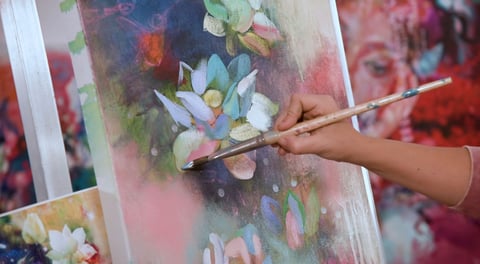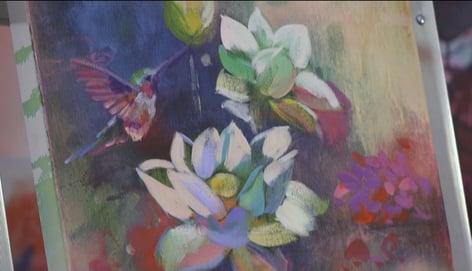
Photo caption: Artful brush strokes create a sense of vibrancy and aliveness in paintings. Photo courtesy of the Milan Art Institute.
They say a picture is worth a thousand words, and without a doubt, this applies to paintings, too! If a painting can speak poetically to our hearts, then the brush strokes within it are the individual letters that string together our brightest thoughts and longings.
It’s one of the reasons why serious students in online painting and drawing classes spend so much time perfecting their brush strokes. They can mean the difference between creating a painting that sells and one that doesn’t.
Brushstrokes record the life of their creator, the artist. They have the ability to almost vibrate with a life of their own. When thoughtfully placed, movement, depth, and emotion cause the painting to shine with enticing beauty.
Impact. Confidence. Excellence. No brush stroke is insignificant, and allowing your brush strokes to show in your own paintings allows you to leave your artistic mark on the world and have the potential to attract ardent collectors of your work.
This is important if you want to learn how to become a professional artist, and maybe more particularly, if you’re learning how to paint abstract art. It’s often the brush strokes that makes these pieces of art exceptional and masterful.
Video caption: See How Dafni Milan Stacks Her Brush Strokes in an Abstract Painting
How to Create More Beautiful Brush Strokes in Your Art
The key to retaining beautiful marks is to stack the paint, not blend it. Although it can be incredibly tempting to smooth out the paint on the canvas, accuracy and precision can be achieved as well as liveliness with intentional stacks of color.

Photo caption: Learning how to create artful brush strokes can have an impact on how sellable your art is.
With focus and confidence, keep the forms of your subject in mind and work towards realism by planting and leaving your marks. This is particularly easy to do with acrylic paint because it dries quickly.
Refining and bringing out vibrant color can be done afterward with oil paint, and you will look back with awe and satisfaction at your kaleidoscopic (but excellently crafted) work of art.
There is a unique kind of freedom to be found in the process of allowing each mark to be recorded unedited.
Yes, it does take self-control, but it strengthens your ability to trust yourself, instead of second-guessing your judgement. This allows you to clearly communicate to your viewers (and collectors) that you have masterful skill and craftsmanship.
Video caption: Tips for Students and Professional Artists: How to Clean Oil Paint Brushes
How to Paint Better: Use Brush Strokes to Your Advantage
Another benefit of laying down paint this way is that it gives you the opportunity to be okay with the “ugly stage” of a painting. All paintings go through ugly stages, but many artists don’t have the right training to know how to move past this.
Learning how to stack your brush strokes alleviates this issue. Instead of laboring over individual areas at a time, adding brush strokes gradually to every part of the painting unifies the piece without making it stiff.
It might be disheartening to see at first, but don’t give up! Grow in patience, and it will all come together beautifully in the end.
If you want to learn more about how to create beautiful, enticing brush strokes, then join our interactive Milan Art Community or try our free online art course 50 Ways to Lay Down Paint.
Want More Quick Tips for Improving Your Art Techniques?
How To Choose Your Brush
Art Resources: A Quick Guide to Artists’ Brushes
Art Marketing Tips: 5 Things to do to Prepare for an Art Fair

